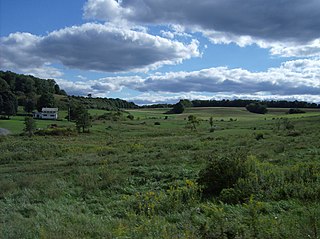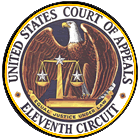
The Fourth Amendment to the United States Constitution is part of the Bill of Rights. It prohibits unreasonable searches and seizures and sets requirements for issuing warrants: warrants must be issued by a judge or magistrate, justified by probable cause, supported by oath or affirmation, and must particularly describe the place to be searched and the persons or things to be seized.
In United States criminal law, probable cause is the legal standard by which police authorities have reason to obtain a warrant for the arrest of a suspected criminal and for a court's issuing of a search warrant. One definition of the standard derives from the U.S. Supreme Court decision in the case of Beck v. Ohio (1964), that probable cause exists when “at [the moment of arrest] the facts and circumstances within [the] knowledge [of the police], and of which they had reasonably trustworthy information, [are] sufficient to warrant a prudent [person] in believing that [a suspect] had committed or was committing an offense.”
In law, a dwelling is a self-contained unit of accommodation used by one or more households as a home – such as a house, apartment, mobile home, houseboat, recreational vehicle, or other "substantial" structure. The concept of a dwelling has significance in relation to search and seizure, conveyancing of real property, burglary, trespass, and land-use planning.

The open-fields doctrine, in the U.S. law of criminal procedure, is the legal doctrine that a "warrantless search of the area outside a property owner's curtilage" does not violate the Fourth Amendment to the United States Constitution. However, "unless there is some other legal basis for the search," such a search "must exclude the home and any adjoining land that is within an enclosure or otherwise protected from public scrutiny."
Florida v. Riley, 488 U.S. 445 (1989), was a United States Supreme Court decision which held that police officials do not need a warrant to observe an individual's property from public airspace.
California v. Greenwood, 486 U.S. 35 (1988), was a case in which the Supreme Court of the United States held that the Fourth Amendment does not prohibit the warrantless search and seizure of garbage left for collection outside the curtilage of a home.
Kyllo v. United States, 533 U.S. 27 (2001), was a decision by the Supreme Court of the United States in which the court ruled that the use of thermal imaging devices to monitor heat radiation in or around a person's home, even if conducted from a public vantage point, is unconstitutional without a search warrant. In its majority opinion, the court held that thermal imaging constitutes a "search" under the Fourth Amendment, as the police were using devices to "explore details of the home that would previously have been unknowable without physical intrusion." The ruling has been noted for refining the reasonable expectation of privacy doctrine in light of new surveillance technologies, and when those are used in areas that are accessible to the public.
In United States constitutional law, reasonable expectation of privacy is a legal test which is crucial in defining the scope of the applicability of the privacy protections of the Fourth Amendment to the U.S. Constitution. It is related to, but is not the same as, a right to privacy, a much broader concept which is found in many legal systems. Overall, reasonable expectations of privacy can be subjective or objective.
Oliver v. United States, 466 U.S. 170 (1984), is a United States Supreme Court decision relating to the open fields doctrine limiting the Fourth Amendment to the United States Constitution.
United States v. Dunn, 480 U.S. 294 (1987), is a U.S. Supreme Court decision relating to the open fields doctrine limiting the Fourth Amendment of the U.S. Constitution.

United States v. Hatch, 931 F.2d 1478, cert. denied, 502 U.S. 883 (1991) is a United States Court of Appeals for the Eleventh Circuit court decision relating to the open fields doctrine limiting the scope of the Fourth Amendment of the U.S. Constitution.

United States v. Pace, 955 F.2d 270, cert. denied, 502 U.S. 883 (1992) is a United States Court of Appeals for the Fifth Circuit court decision relating to the open fields doctrine limiting the scope of the Fourth Amendment of the U.S. Constitution.
California v. Ciraolo, 476 U.S. 207 (1986), was a decision by the Supreme Court of the United States in which the Court held that aerial observation of a person's backyard by police, even if done without a search warrant, does not violate the Fourth Amendment to the U.S. Constitution.
Soldal v. Cook County, 506 U.S. 56 (1992), was a United States Supreme Court case in which the Court held that a seizure of property like that which occurs during an eviction, even absent a search or an arrest, implicates the Fourth Amendment. The Court also held that the Amendment protects property as well as privacy interests, in both criminal as well as civil contexts. Finally, saying that "certain wrongs affect more than a single right", the Court left open the possibility that the Fourteenth Amendment's protections against deprivation of property without due process of law may also be implicated.
In United States Constitutional Law, a minimally intrusive/invasive warrantless search is a type of search that does not breach the boundaries of the property and is performed without any prerequisite search warrant. These searches are contested regularly in courts, and have been ruled for and against under different circumstances. The primary debate concerns the method in which the search is conducted, and also the area being searched. Issues concerning warrantless search and subsequent seizure are always of local concern, because they are a community law enforcement issue as well as a national law issue.

Florida v. Jardines, 569 U.S. 1 (2013), was a United States Supreme Court case which resulted in the decision that police use of a trained detection dog to sniff for narcotics on the front porch of a private home is a "search" within the meaning of the Fourth Amendment to the United States Constitution, and therefore, without consent, requires both probable cause and a search warrant.
Dow Chemical Co. v. United States, 476 U.S. 227 (1986), was a United States Supreme Court case decided in 1986 dealing with the right to privacy and advanced technology of aerial surveillance.
Collins v. Virginia, No. 16-1027, 584 U.S. ___ (2018), was a case before the Supreme Court of the United States involving search and seizure. At issue was whether the Fourth Amendment's motor vehicle exception permits a police officer uninvited and without a warrant to enter private property, approach a house, and search a vehicle parked a few feet from the house that is otherwise visible from off the property. In an 8–1 judgment, the Supreme Court ruled that the automobile exception does not apply to vehicles parked within the home or the curtilage of a private homeowner.

The aerial surveillance doctrine is the legal doctrine in the United States of America that under the Fourth Amendment, aerial surveillance of an individual’s property does not inherently constitute a search for which law enforcement must obtain a warrant. Courts have used several factors–sometimes only one or a few, other times many or all of them–to determine whether the surveillance in question is a search in violation of one’s constitutional rights: the object of the surveillance, the technology employed, the duration of the surveillance, scope of aggregated information, and the vantage point from which the surveillance is conducted.





